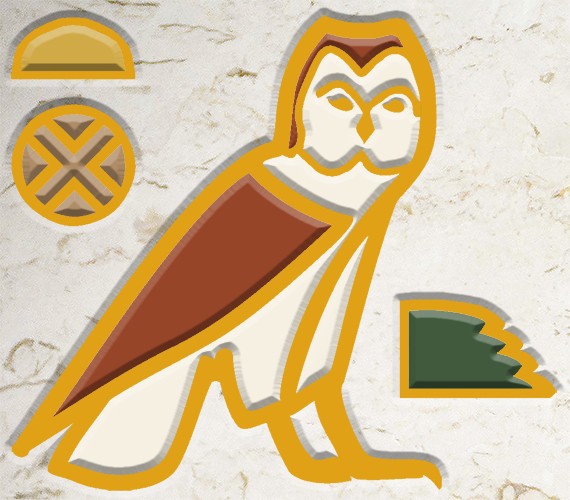This perfect place, the Nome of R’a Har (Horus-Ra, Edfu), is His horizon on earth, is the House of Appearance of His Majesty (Horus of Edfu), is the Great Throne of his Ka’ spirit, on which he appears in morning and sets in evening, is the Shrine that Protects Khapar (Khepri) of the quickly born child, is the place at which his body has been nourished since the Sap Tapya – First Time, is the djaryat – chamber of the djartya – falcon, is the Ruler’s House of the ruler, is the tomb of the falcon with the Dappled Plumage, is the Great Place of the greatest of the Natjrw – deities, is the House of the Strong One of Har (Horus), the strong bull, is the Palace of the Revenger (Horus), who drives the hot-headed (enemies) from the land, is the Place of Stabbing of the one who stabs the iwmasatya Serpent (Apophis), is the Horizon of Eternity and Primeval Hill of the horizon deity (Horus), is the Shrine of the divine Winged Disk (ﻉpya).
His Majesty (Horus) shines daily, high in the heavens, after he has illuminated the Two Lands (Egypt) with his beauty. When Behdety has come down from heaven, he, the Lord of the Natjrw, enters his palace, where he is received with hymns of praise by the Pasadjatyw (divine Ennead). All those who live in Masan (Edfu) rejoice. He sees that Ma’ﻉat is lit up in Edfu as Hwt Har (Hathor), the Great One and Mistress of Dandara, and that Her handsome son, Har sama’ ta’wya (Horus, uniter of the Two Lands) beloved of all, has taken His place beside Her. When He has recognized that perfection flourishes in his temple and that all the cult therein is according to rule, His heart rejoices. After he has become united with his statue, he praises Rﻉ because of his beloved city. There is jubilation in heaven and rejoicing on earth. The Banks of Har (Egypt) are in festive mood and the Throne of Har (Edfu) is in festive joy.
The House of the Falcon rejoices after R’a Har has united with the Golden One, the Mistress of Dendera, after the king and the queen have come together while their son sits at their side as king of Upper and Lower Egypt, these, who are the Enduring Ones of Edfu, the rulers of Kamat (Egypt), the Ka’w (spirits) of Kamat, who keep ta’wya alive.
After Har BaHadatya (Horus Behdety), the great God and Lord of Heaven, with the Dappled Plumage, who comes forth from the horizon, the Naswt Bitya (ruler of Upper and Lower Egypt), has seen the Enclosure wall that surrounds his temple as the horizon surrounds the sun-disk, the superb building of which there is no equal, constructed for him by the Naswt Bitya, the heir of Euergetes II (Ptolemy X), he praises His beloved son for his work and gives Him all that is encompassed by his itan (sun disk) when he has appeared as Naswt Bitya on the throne of Har as the first of the living Ka’w, forever.
The magnificent ﻉpya revealed Himself in heaven as BaHdatya, the great God and Lord of Heaven, and made his way to His nome (Edfu). He found his shrine pleasant and took his place on his throne. He looked at this perfect work, constructed for him by his beloved heir, the King of Upper and Lower Egypt The Heir of Euergetes II, the Son of Rﻉ Ptolemy X Alexander I, beloved of Har BaHdatya, the Great God and Lord of Heaven, with the Dappled Plumage, who comes forth from heaven as Rﻉ Har A’khatya (Ra-Horakhty) to his Great Seat. He looked at this perfect and splendid monument in Masan, the like of which had never been constructed since the time of the primeval gods, this great wonder without precedent and never there since the time of the gods, this magnificent construction without equal among the temples of Kamat.
– The Great Building Inscription of the Edfu Temple
About the Temple
The physical temple of Horus at Edfu is the site of one of the oldest places of the worship of Har (Horus). Edfu sits on the earlier town named Wtjasat Har (The Place where Horus is extolled). A very prosperous town, due to its proximity to routes to nearby gold mines in the eastern desert.
The town had both a sacred name and a secular name. Its sacred name being BaHdat meaning ‘great seat’ or ‘throne’. Its secular name was Djaba’a, meaning ‘Place of Retribution’, alluding to its mythology as the place where the enemies of Rﻉ were brought to justice. By Coptic times the town Djaba’ was pronounced Etbo, and were it became the Arabic Edfu.
The earliest stone temple is attested to being designed by Imhotep, vizier and chief architect to Djoser (c. 2600 b.c.e.) and a woman named Kharadw ‘anakh. Little is known of that temple, except that it was dedicated to the triad of Har BaHdatya (Horus Behdety), His consort Hwt Har (Hathor) of Dandara, and Their son Har sama’ ta’wya (Horus, uniter of the Two Lands).
Over the millennia, several Pharaohs contributed to the building of the Temple, including Sety I (1294-1279 b.c.e.), Ramesses II (1279-1213 BCE), Ramesses III (1184-1153 BCE) and Nectanebo II (360-343 BCE). Most of what stands today is attributed to the massive temple building of Ptolemy III Euergetes II (246-222 BCE).
Work on the Ptolemaic temple began in 237 BCE Formal dedication of the inner naos of the temple was performed by Ptolemy VIII Euergetes II and his wife Cleopatra II on 10 September 142 BCE Work continued, with greater additions added by the succeeding Pharaohs, and in 57 BCE the pylon doors were hung and the temple completed.



Be First to Comment